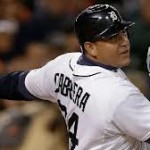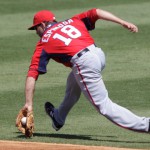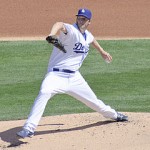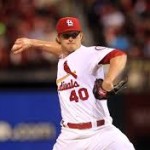Who might the team protect ahead of the Rule-5 Draft this year? The topic came up recently in the comments so I thought i’d publish this post to open up the debate again. I’ve got a rule-5 history post as well that i’ll post later this week. And, as it turns out, Nov 20th is the deadline for adding players to the 40-man, so today’s as good a day as any to discuss. (Kilgore’s analysis here, Baseball’s off-season calendar here).
The Nats off-season rule-5 protection debate really started in late August with an observation made about Zach Walters from Adam Kilgore in his pre-Sept 1 callup piece on 8/27/13. It was continued by the announced list of Nats AFL participants, which included a couple of significant Rule-5 protection candidates. Walters was subsequently added to the 40-man and called up, ending any Rule-5 speculation.
As (allegedly) was Steve Souza, who hit the cover off the ball in AA in 2013, with power to go with his CF defensive capabilities. He followed that up by hitting .357 in the AFL, trailing just mega-prospects Kris Bryant and C.J. Cron for top hitting honors in Arizona. I say Souza was “allegedly added” to the 40-man because, while news of his 11/1/13 40-man addition was widely published at the time, but his name does not appear on MLB.com’s 40-man roster for the team nor does there exist an 11/1/13 transaction (Editor’s update: it was posted 10/31/13 and the MLB 40-man database was missing him in error; it was eventually fixed). I don’t know if its just a procedural thing or if all the beat reporters mis-reported the event and it should have been characterized as a “planned future” move. But I’ll assume for the rest of this article that Souza is going to be put on the 40-man before the rule-5 draft.
Two of the most obvious Rule-5 candidates (even if Souza was technically a minor league free-agent to be) are now protected. Who else might we see added?
Using the indispensable sites Draft tracker and the Big Board, and then giving some thought to prospect acquisitions made via trade, here’s some thoughts. The quick rule-5 rules; any college-aged draftee from 2010 or before who isn’t already on the 40-man roster is Rule-5 eligible this coming off season, and any high-school aged draftee from 2009 or before is newly eligible this year.
Newly Eligible Players this year worth consideration for protection:
- Rick Hague: 2B/SS from Harrisburg; .673 OPS in AA, not good enough OBP for a middle infielder and no power. He’s well down the pecking order of backup middle infielders in this organization right now, and wouldn’t be a great organization loss even if he was selected. Chances of being drafted or protected: very slim.
- Jason Martinson: SS from Potomac/Harrisburg: Martinson finally earned a promotion above A-ball, where he promptly hit .185 in AA in 54 games. He showed a ton of power in 2012 for a SS (22 homers) but it was in Low- and High-A ball. Maybe he is a late bloomer. However he’s not in jeopardy of being protected or drafted at this point.
No other 2010 college aged drafted hitter has even made it to Harrisburg; so they’re not going to get drafted or protected. This includes three draft picks in the first 10 rounds of that draft; understandable in that the team committed millions to 3 top guys in 2010 and skimped elsewhere.
- Sammy Solis: LHP with Potomac: coming back from injury in 2013 he pitched in Potomac the whole season. He was a bit “old” for A-ball but its understandible considering where he’s been. He excelled in the AFL and is being mentioned as a possible Loogy with the big-league team, so I’d have to think he’s a lock to be protected ahead of the draft.
- Harrisburg middle relievers Matthew Grace, Aaron Barrett and Neil Holland: all three have good to excellent numbers in relief this year for AA Harrisburg. Barrett especially as the closer. Grace is left-handed and could feature as someone’s loogy. Tough calls here; you can make a case that the team would like to retain all three guys as bullpen reinforcements in the coming years. You can also make the riskier case that all three guys, while valuable and skilled players, may not stick on a MLB roster the entire year so perhaps they’re good bets to be left unprotected versus someone already on the 40-man roster.
The rest of the remaining 2010 college-age draftees are all either currently on the DL or are in Hagerstown or below, making them very slim candidates to be protected or picked. Cameron Selik was one guy who could have made some noise, but he got hurt this year and isn’t going to get picked.
- 2009 High School-age drafted players newly eligible: just Michael Taylor, who has a ton of speed (51sbs) and an improved OBP (.340) while repeating high-A this year. I know there are readers here who like Taylor a ton, so this isn’t spoken out of disrespect. I think Taylor has potential. Maybe he “made the leap” in 2013. Maybe he’s going to light up AA next season and suddenly we’re talking about him being Denard Span‘s replacement and not Brian Goodwin. However, I can’t see someone rolling the dice with him in a rule-5 situation. He’s never played above A-Ball. In today’s modern game, with 12 man bullpens and thus shortened benches, I just can’t see someone like Tayler getting carried for an entire year. I think the team may very well roll the dice and leave him exposed in December, and revisit 40-man protection in 2014.
Rule-5 holdovers from before of Note
- Last year’s selections Erik Komatsu and Danny Rosenbaum: Komatsu has been hurt all year, Rosenbaum was decent but not over-powering in AAA. Neither guy seems worth protecting since they already were selected and failed to stick. But, they’re both AAA-level talents who could be someone’s bench player/swing man so they may get plucked again if not protected.
- Justin Bloxom and Sean Nicol are both college-aged 2009 draftees with run-of-the-mill numbers in AA; they’ll play out the string until they get pushed out at this rate.
- Patrick Lehman ended the season on the DL, making one think he’s not likely to get drafted. Well that and his numbers were not good.
- Matt Swynenberg has looked better in AA than he did in high-A; has he done enough to garner some interest from another team?
- Destin Hood: our 2nd round pick in 2008 just seems to be spinning his wheels; his batting average has dropped as he’s repeated a level. He’s officially in bust status.
- Adrian Nieto has earned a placement in the Arizona Fall League and was Rule-5 Eligible last year, but was not drafted. He’s yet to rise above high-A and seems a long shot to be taken (though, the Nats did pretty well plucking one Jesus Flores out of the Mets high-A team one year).
So, who’s getting protected? As of the time of this writing, the Nats roster sits at 39 of 40 (again, assuming Souza is really there), so there’s just one empty spot. But there’s at least a few guys on the fringes of the 40-man who I think could be waived and have a high likelihood of being kept (namely, Tyler Robinson and Corey Brown) if the team thought it needed room for either protectees or free agents. The back-end of this roster is getting a bit clogged.
Depending on how many spots the team keeps open, in order I’d protect Solis, Barrett, Tayler, Grace, and Holland. For me, only Solis is a lock. The rest (for reasons described above) may be calculated omissions.








